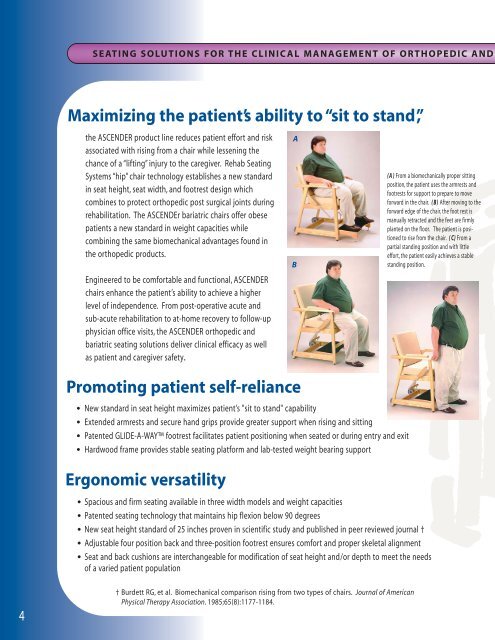Seating Solutions - Rehab Seating Systems, Inc.
Seating Solutions - Rehab Seating Systems, Inc.
Seating Solutions - Rehab Seating Systems, Inc.
Create successful ePaper yourself
Turn your PDF publications into a flip-book with our unique Google optimized e-Paper software.
4<br />
SEATING SOLUTIONS FOR THE CLINICAL MANAGEMENT OF ORTHOPEDIC AND<br />
Maximizing the patient’s ability to “sit to stand”,<br />
the ASCENDER product line reduces patient effort and risk<br />
associated with rising from a chair while lessening the<br />
chance of a “lifting” injury to the caregiver. <strong>Rehab</strong> <strong>Seating</strong><br />
<strong>Systems</strong> “hip” chair technology establishes a new standard<br />
in seat height, seat width, and footrest design which<br />
combines to protect orthopedic post surgical joints during<br />
rehabilitation. The ASCENDEr bariatric chairs offer obese<br />
patients a new standard in weight capacities while<br />
combining the same biomechanical advantages found in<br />
the orthopedic products.<br />
Engineered to be comfortable and functional, ASCENDER<br />
chairs enhance the patient’s ability to achieve a higher<br />
level of independence. From post-operative acute and<br />
sub-acute rehabilitation to at-home recovery to follow-up<br />
physician office visits, the ASCENDER orthopedic and<br />
bariatric seating solutions deliver clinical efficacy as well<br />
as patient and caregiver safety.<br />
Promoting patient self-reliance<br />
• New standard in seat height maximizes patient’s "sit to stand" capability<br />
• Extended armrests and secure hand grips provide greater support when rising and sitting<br />
• Patented GLIDE-A-WAY footrest facilitates patient positioning when seated or during entry and exit<br />
• Hardwood frame provides stable seating platform and lab-tested weight bearing support<br />
Ergonomic versatility<br />
• Spacious and firm seating available in three width models and weight capacities<br />
• Patented seating technology that maintains hip flexion below 90 degrees<br />
• New seat height standard of 25 inches proven in scientific study and published in peer reviewed journal †<br />
• Adjustable four position back and three-position footrest ensures comfort and proper skeletal alignment<br />
• Seat and back cushions are interchangeable for modification of seat height and/or depth to meet the needs<br />
of a varied patient population<br />
† Burdett RG, et al. Biomechanical comparison rising from two types of chairs. Journal of American<br />
Physical Therapy Association. 1985;65(8):1177-1184.<br />
A<br />
B<br />
(A ) From a biomechanically proper sitting<br />
position, the patient uses the armrests and<br />
footrests for support to prepare to move<br />
forward in the chair. (B) After moving to the<br />
forward edge of the chair, the foot rest is<br />
manually retracted and the feet are firmly<br />
planted on the floor. The patient is positioned<br />
to rise from the chair. (C) From a<br />
partial standing position and with little<br />
effort, the patient easily achieves a stable<br />
standing position.<br />
C


